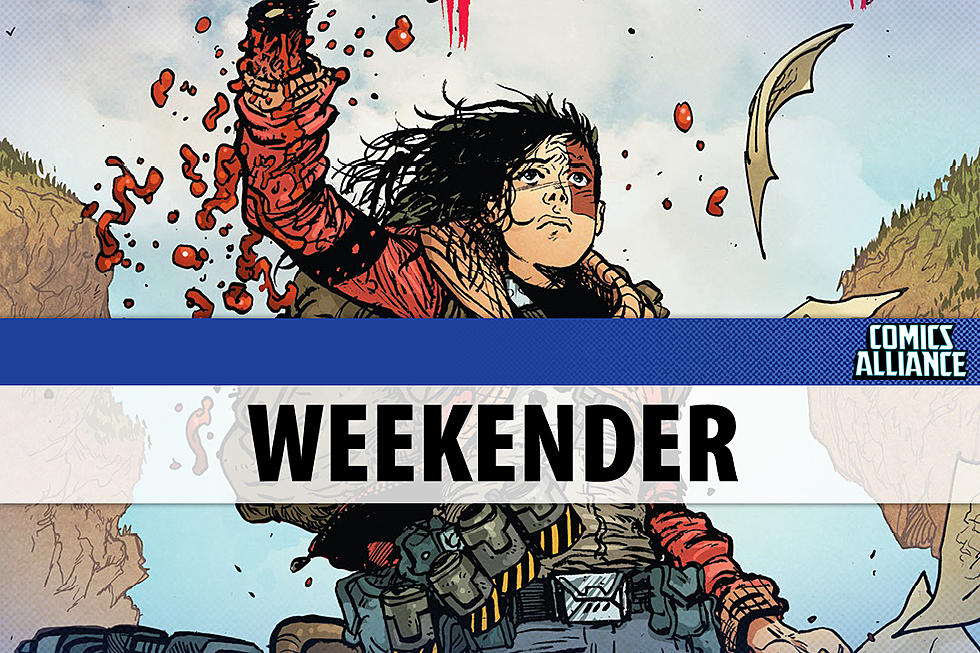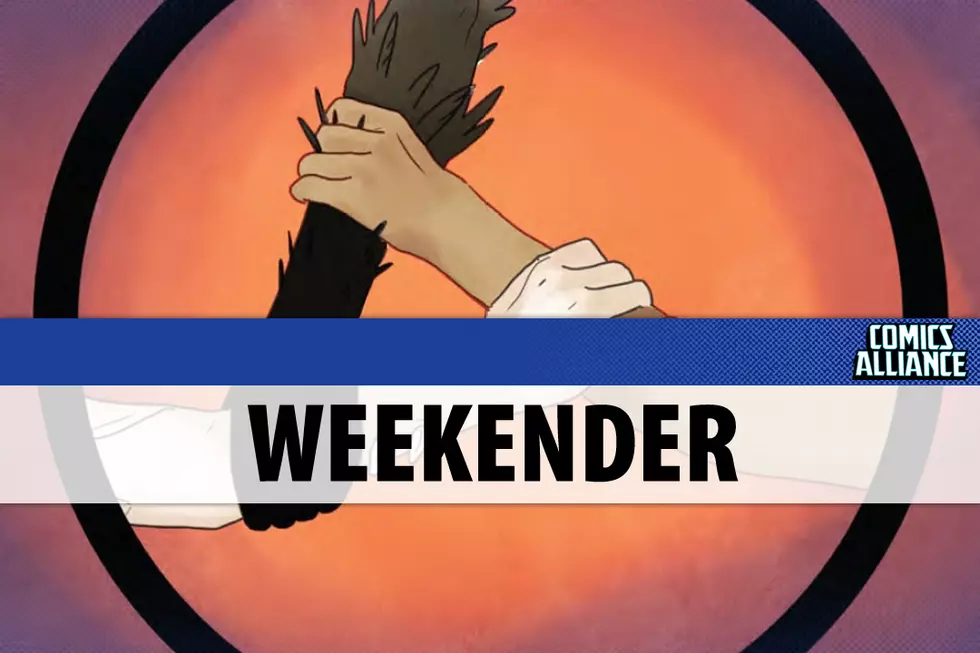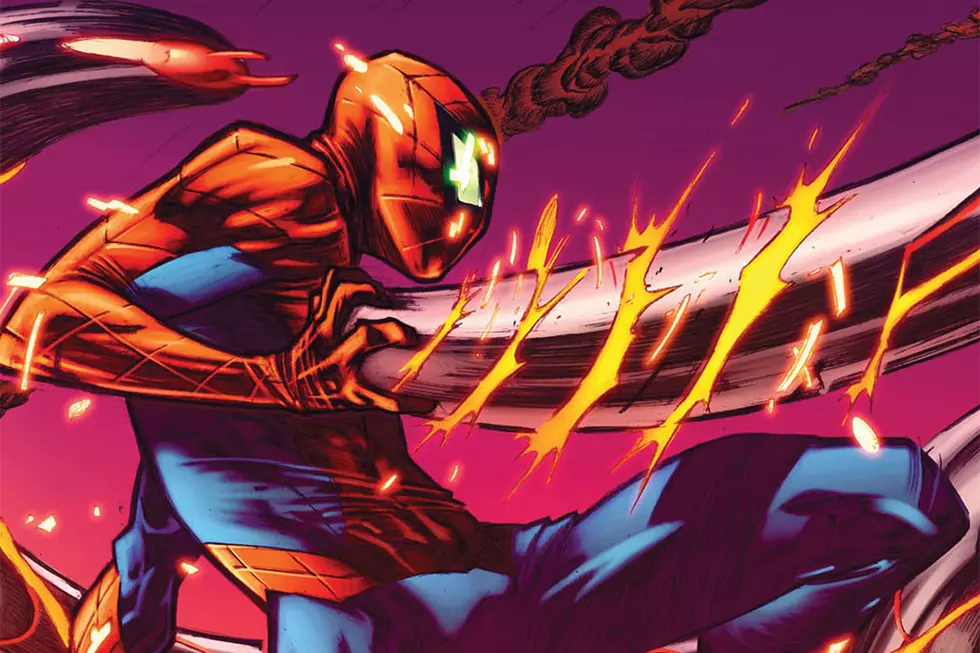
‘And Then Emily’ Returned… for Free Comic Book Day: In Conversation with Lees and Laurie
Visiting the bustling hive of energy that was Edinburgh Comic Con back in mid-April, I was delighted to see that the table of dynamic duo John Lees and Iain Laurie had completely sold out of their critically acclaimed horror comic, And Then Emily Was Gone.
The guys told me of their surprise that the table had been decimated, and that their talk had been given to a very full auditorium. The two, it seemed, were a little staggered by the reaction to their dark and surreal labour of love, and the fan response to their presence.
With full disclosure I shall admit that Laurie is one of my all time favourite artists, who is surely due worldwide recognition, and his unique linework is ably caressed by the sickly shades of Megan Wilson, and the intimate lettering of Colin Bell.
With a highly anticipated prequel, And Then Emily Was Gone #0, as one of the highlights of the 2015 Free Comic Book Day slate, what better time to sit down and talk horror, David Lynch, Scottish folklore, and how such a wicked comic ever reached our shelves with Lees and Laurie?
ComicsAlliance: I think it’s no understatement to say that And Then Emily Was Gone was one of the indie smash hits of 2014 --- the critics loved it, the fans loved it, and it sold out everywhere. How are you guys dealing with your newfound fame?
John Lees: Thanks for the kind words, Laura! I think the easiest way to deal with any newfound "fame" is to keep things in perspective: when I go to a convention, the majority of people I talk to have never heard of me and have never read And Then Emily Was Gone. And that's a good thing! There's always scope to expand your audience and attract new readers. But really, the response to And Then Emily Was Gone has been astounding. It's been so gratifying to see people really seem to connect with it.
CA: For those unfortunate souls who have yet to read the comic, can you tell them a little about what And Then Emily Was Gone is about?
JL: And Then Emily Was Gone is a horror series that begins with a former police detective called Greg Hellinger. Back in the day, he was famed for cracking some seemingly unsolvable missing persons cases, but five years ago he had what most believe to have been a mental breakdown, and ever since, he's been tormented by horrific apparitions of monsters that follow him around wherever he goes. He's pulled from his life of despair and squalor by a teenage girl called Fiona, who has tracked down Hellinger in hopes of him using his particular skill-set to track down her missing best friend, Emily.
The official story is that Emily ran away from home, but Fiona is convinced that a local child-snatching boogeyman by the name of Bonnie Shaw has taken her. Hellinger agrees to help Fiona, and their search takes them to the Orkney islands, and the remote community of Merksay, where strange and terrible things start to happen!
CA: For US and other international readers, what exactly are the Orkney Islands and what makes them suitable as a location for this kind of tale? I mean as a fellow Scot I know our lands are riddled with the forgotten curses of chaos magicians…
JL: Orkney is a collection of islands in the north of Scotland. There are 70 Orkney islands, though only 20 of those are inhabited by people. Their suitability for this kind of tale mainly ties into how relatively remote they are, and how there is a rich tradition of isolated communities and how they tap into that fear of the unknown within the horror genre. There is also some interesting, suitably macabre folklore in Orkney built around trows, known for snatching infants and replacing them with changelings, which we play with and build on in our story. I should point out, though, that all the people from Orkney I've talked to have been lovely and normal.
CA: How did your slot in Free Comic Book Day come about, and are there any other sneaky plans to revisit the island of Merksay?
JL: The Free Comic Book Day slot was down to Tyler James at ComixTribe. He's built up a good rapport with the FCBD organisers, to the point where the publisher being represented in the lineup each year is becoming a tradition. So, when he invited Iain and I to come up with a prequel story for And Then Emily Was Gone #0, I jumped at the chance. At the moment, there are no plans beyond this to revisit Merksay and the world of And Then Emily Was Gone, but we're going out with a bang, as I believe this is our scariest story yet!
CA: As a big fan of old school British and Euro horror films, I’m spotting a bit of The Blood on Satan's Claw and The Wicker Man at play as influences, and perhaps some of The League of (not-extraordinary!) Gentlemen? What inspired you to reach the depths of wickedness contained within? (Also got Children of the Stones and Vic and Bob’s Randall & Hopkirk (Deceased) to pop into my head, but that may very well just be me!)
JL: I always love this question when it pops up in interviews, as I feel like I'm able to give a slightly different answer every time! There's a big melting pot of influences. All the ones you name-checked are certainly in there, And Then Emily Was Gone definitely taps into that vein of British rural horror. Twin Peaks is the really obvious influence, the works of David Lynch in general, really. Also, the films of Ben Wheatley, and for me, maybe a touch of M.R. James ghost stories, too.
Iain Laurie: You've got most of them there. League Of Gentlemen, Vic and Bob (especially Catterick), Dennis Potter, Ben Wheatley, Hammer Horror and of course my absolute hero David Lynch who infects everything I do with his genius.
CA: Throughout the original release schedule of the series I was a regular reader of the Visit Merksay website, a blog that featured rather chillingly told in-world history and Merksay stories. What sparked the idea of having this interactive aspect to the comic?
JL: I just think it's really fun to do stuff like that to build up the world of your comic. I did something similar back before my first comic, The Standard, was released. It's a nice way of adding some depth and history to your mythology beyond what the constraints of the comic page allow, and I feel it's more interesting than just straightforward promotion.
CA: With the comic published through ComixTribe, it is a rare example of a Scottish indie comic available across the US as well as the UK. Was the publisher immediately on board with And Then Emily Was Gone? And how did the variant covers come about on ComixTribe’s first monthly series?
JL: I think it's okay to tell this story now, since Tyler James has himself admitted it in a column he wrote a while back, but ComixTribe originally wasn't too enthused with And Then Emily Was Gone. I remember I'd sent over a couple of black-and-white, unlettered early pages, and they didn't quite get where Iain and I were going with this. It was drastically different from The Standard, and not really like anything else ComixTribe was publishing. And Tyler came to the not-unreasonable conclusion that because the story is so strange and offbeat, it might not have been the easiest project to market.
But when I travelled over for New York Comic Con 2013, Tyler kindly invited me to bring along any copies I had of the original, self-published black-and-white run of issue #1 to sit at the corner of the ComixTribe table. I did, and surprisingly, the book ended up being the hottest-selling comic at the table that weekend! I think seeing first-hand how people responded to the concept and to Iain's stunning artwork really opened ComixTribe's eyes to how this could actually be a really cool project for them to get behind, and so they said the door was open for us to publish the book through them if we so chose... and we ended up taking them up on the offer!
And I'm glad we did, as the ComixTribe team have been fantastic in really getting behind the book and going the extra mile to promote it, and they're all super-cool, genuinely nice guys who are dedicated to making the best comics they can. I'll maybe hand over to Iain to talk about the variant covers!
IL: With the variant covers, it all came down to people liking the book and wanting to help out. Nick Pitarra (The Manhattan Projects) was an early supporter, and I think most of the success of the book comes down to him believing in it, hooking us up with Megan [Wilson], doing the cover to #2 and getting the equally amazing Riley Rossmo to do #1 and future superstar Cody Schibi to do #5. We were really fortunate.
For #3, I asked Garry Brown, who's an old mate, to do a cover which was really kind of him. Then again, I know enough to destroy him. :) And finally, Joe Mulvey gave us a phenomenal cover to #4. Joe is a great guy and an amazing artist and everyone should pick up his fantastic SCAM book. All of them pitching in for free was astounding and really kind. Without people of their level helping out we could easily have got lost in the rush.
CA: It’s a surreal and horrific ride to nightmareville so I can’t help but ask, how on earth did this comic come to be?! It almost seems impossible to imagine it being carried out in any other medium.
JL: I wouldn't say it's impossible to tell this story in any other medium. Indeed, many of our influences came from film and TV, as discussed above! But at a most basic level, I'd say this project came from Iain and I wanting to make a comic we would want to read. We had paired up to work on something for a big anthology project that never materialised, but we so enjoyed that experience of collaboration that we decided to work on something of our own. So, Iain threw a bunch of concepts and characters in my direction, which I tinkered around with and merged into what became the skeleton of And Then Emily Was Gone.
CA: Iain, if I could zoom in on you for a second – I’ve been a big fan since first reading your work with Craig Collins (Roachwell, Crawl Hole, Metrodome) which bowled me over by its sheer uniqueness, reminding me only a little of an Electric Soup era Frank Quitely. This is your first serial narrative --- how did your approach differ, and what are your major influences in general?
IL: My approach differed in that I had genuinely no idea what I was doing in terms of drawing a proper comic. That's one of the reasons I took it on to see if I could. I'm still not sure :) I just took it a page at a time really and hoped for the best.
Artwise, there's so many. Frank Quitely is a HUGE influence (and a big early supporter of mine) also the Scottish painters John Byrne and Peter Howsen, Ian Bertram, Nick Pitarra, Jeff Lemire, Ken Reid, Tony Millionaire. I pick up bits from all of them.
CA: I noticed that you have a rather interesting approach to your panel work and transitions --- panels are lopsided, interrupting each other, borders disappear and reappear with no notice, and transitions and distances are delightfully unpredictable. The result being that I was far more absorbed in the storyline, and far more easily shocked! What are your techniques when designing layouts and interpreting the script?
IL: As I said earlier, it's all about David Lynch for me and what I always loved about his films is that they have that sense of unease and I always try to have that in my stuff. Basically I try and keep the viewer on the back foot a bit so that if there's a place where the reader expects a long shot, I zoom in for an extreme close-up. I always try and go where you least expect it and hope the story still rolls along. I also like to play with the idea that it's happening off-world where the normal rules don't apply. As you can see, it's hard to explain.
CA: And Then Emily Was Gone #0 hits the shelves on Free Comic Book Day, Saturday May 2nd. What next will crawl from the desks of Lees and Laurie? I’ve heard rumours of Oxymoron related shenanigans, and a possible dream team-up with Owen Michael Johnson (Raygun Roads, Beast Wagon)?
JL: I can exclusively confirm that I won't be drawing Owen Michael Johnson's next comic book! Sorry to disappoint you all. However, this August, my next monthly comic from ComixTribe does hit comic shops worldwide. It's called Oxymoron: The Loveliest Nightmare, and it takes ComixTribe's popular supervillain from The Red Ten and places him in a more grounded, crime-thriller, Se7en/The Silence of the Lambs type setting. I guess you could say it's a prequel, but it's really designed in a way where it can be its own totally self-contained narrative.
The way I've been pitching the series is, "Imagine if the Joker showed up in a Gotham City where Batman didn't exist". And so regular cops, politicians, the media, they have to deal with this homicidal force of nature causing carnage in their city on a scale they just aren't equipped to deal with. I've been drawing influence from crime narratives so dark they peek into horror territory: Korean thrillers like I Saw the Devil and even a bit of Italian giallo like Deep Red. This could be the nastiest, most mean-spirited thing I've ever written!
IL: Owen's amazing and we've talked about doing something for ages and I'm sure it'll happen one day. I haven’t anything definite lined up. Me and John have a thing we'd like to do, and I've been working on a pitch with Steve Orlando (Midnighter, Undertow) and I think even if that doesn’t happen we'll still do something else. There's loads of people I'd like to work with. I'd love to do some of my own stuff.
And Then Emily Was Gone #0 is just one of the bounty of free comics available from your local comic store this Saturday, May 2nd!
More From ComicsAlliance
![The Early Turtle Gets The Wyrm In ‘Teenage Mutant Ninja Turtles Universe’ #6 [Exclusive Preview]](http://townsquare.media/site/622/files/2017/01/TMNT_Universe_06-pr-0.png?w=980&q=75)








